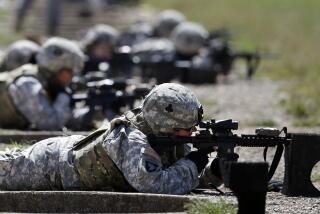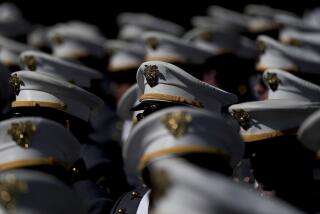Military Women Find the Door Still Closed : High-level study on combat roles offers no clear guidelines
The long-awaited recommendations from the Presidential Commission on the Assignment of Women in the Armed Forces are a major disappointment. After eight months of fractious debate and testimony, the commission this week set forth few clear guidelines on more fully integrating women into the military. Instead, it has further confused legitimate questions about women’s capabilities with fears about what women should be allowed to do.
The Persian Gulf War graphically demonstrated that the Pentagon’s existing distinction between combat jobs--which are closed to women--and noncombat jobs--open to women--can be a distinction without a difference. Fifteen U.S. women were killed while serving in the Gulf and two were taken prisoner by Iraqi soldiers.
Although many regard the combat exclusion as a necessary shielding of women from the depravation of combat or worse, from torture and violation by the enemy, the ban has struck many others as paternalistic sexism. Indeed, some believe that this second-class legal status may have contributed to a social climate that has resulted in recent instances of sexual harassment in the military.
NO REAL PLAN: Congress in 1991 repealed a legal prohibition against women flying aircraft in combat. However, the action produced no change because neither the lawmakers nor the service secretaries subsequently ordered the military to open those combat jobs to women.
Many expected that after a thorough study, the presidential commission would produce a workable plan for such integration that would garner broad support within the services and in Congress. The 15-member panel, named by President Bush, included current and former members of the military, sociologists and social activists.
But the commission issued a package of inconsistent guidelines that failed to resolve the issue. On one hand, the commission recommended that women be allowed to serve on fighting ships such as destroyers, frigates and aircraft carriers. On the other hand, it supported continuing the ban on women flying combat planes and a prohibition on serving in ground combat jobs and aboard submarines and amphibious vessels.
Worse still, the commission rejected a proposal to undertake a test program in which female aviators would be permitted to train for and fly combat missions.
Two years ago Congress killed a similar experiment that would have opened Army combat jobs to women on an experimental basis. Such a test is needed even more now because two months ago a National Academy of Sciences panel concluded that the services’ existing physical fitness standards are not good predictors of an individual’s performance in particular jobs.
NO REAL TEST: Against this backdrop, the panel’s reluctance to endorse an experiment that could shed light on the question of what women can and should do raises serious questions.
Is the military leadership worried that many women are indeed physically incapable of flying planes or carrying heavy field gear? Or are many military leaders more concerned that an experiment would provide evidence to the contrary--meaning that there would no longer be a justification for maintaining a barrier to women in combat?
The commission’s unsatisfying recommendations are simply advisory, but they nonetheless represent a serious setback for military women. The recommendations seem to be less the product of reasoned and informed consideration than of outdated attitudes about women’s emotional health and physical safety.
Congress and the services must look again at this issue, devise clear performance-based job standards and then open military jobs to all those qualified, regardless of gender.
More to Read
Sign up for Essential California
The most important California stories and recommendations in your inbox every morning.
You may occasionally receive promotional content from the Los Angeles Times.










